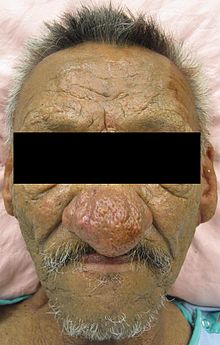| Revision as of 23:48, 20 November 2020 editAnomieBOT (talk | contribs)Bots6,587,172 editsm Dating maintenance tags: {{Cn}}← Previous edit | Revision as of 03:26, 29 November 2020 edit undoTikisim (talk | contribs)Extended confirmed users1,315 edits →Signs and symptoms: Added contentTag: Visual editNext edit → | ||
| Line 27: | Line 27: | ||
| ==Signs and symptoms== | ==Signs and symptoms== | ||
| ] | ] | ||
| Rhinophyma is characterised by prominent pores and a ] thickening of the nose, sometimes with ]s.<ref>{{cite web|title=Rosacea|url=http://dermnetnz.org/acne/rosacea.html|work=Dermnetnz.org}}</ref> It is associated with the common skin condition ]. It can carry a strong psychological impact due to its effect on one's personal appearance.<ref>{{cite web|title=Rhinophyma|url=http://skinchannel.com/rosacea/rhinophyma/|accessdate=24 March 2011}}</ref> | Rhinophyma is characterised by prominent pores and a ] thickening of the nose, sometimes with ]s.<ref>{{cite web|title=Rosacea|url=http://dermnetnz.org/acne/rosacea.html|work=Dermnetnz.org}}</ref> It is associated with the common skin condition ] and it can be classified clinically into 5 grades of increasing severity<ref>Wang, Yan, MD, PhD, Allen, Philip, MB, BS. Giant Rhinophyma. ''Adv Anat Pathol.'' 2020;27(6):422-424. doi:10.1097/PAP.0000000000000282.</ref>. It can carry a strong psychological impact due to its effect on one's personal appearance.<ref>{{cite web|title=Rhinophyma|url=http://skinchannel.com/rosacea/rhinophyma/|accessdate=24 March 2011}}</ref> | ||
| == Controversy on Causes == | == Controversy on Causes == | ||
Revision as of 03:26, 29 November 2020
Condition causing development of a large, bulbous nose, commonly due to untreated rosacea Medical condition| Rhinophyma | |
|---|---|
 | |
| An Old Man and His Grandson, by Domenico Ghirlandaio | |
| Specialty | Dermatology |
Rhinophyma is a condition causing development of a large, bulbous nose associated with granulomatous infiltration, commonly due to untreated rosacea.
Signs and symptoms

Rhinophyma is characterised by prominent pores and a fibrous thickening of the nose, sometimes with papules. It is associated with the common skin condition rosacea and it can be classified clinically into 5 grades of increasing severity. It can carry a strong psychological impact due to its effect on one's personal appearance.
Controversy on Causes
Depending on the sources Alcoholism may or may not be attributed as a cause of this issue. Alcohol, however, may cause increased flushing in those affected.
Pathophysiology
Rhinophyma is a slowly progressive condition due to hypertrophy of the sebaceous glands of the tip of the nose often seen in cases of long-standing rosacea; it is not a cancer. It presents as a pink, lobulated mass over the nose with dilation of the superficial blood vessels; it mostly affects men past middle age. People affected by rhinophyma typically seek advice because of the perceived unsightly appearance of the enlargement, or obstruction in breathing and vision.
Diagnosis
Rhinophyma may be diagnosed without testing, but a skin biopsy can confirm the diagnosis.
Treatment
Treatment consists of paring down the bulk of the tissue with a sharp instrument or carbon dioxide laser and allowing the area to re-epithelialise. Sometimes, the tissue is completely excised and the raw area skin-grafted.
References
- Cohen AF, Tiemstra JD (2002). "Diagnosis and treatment of rosacea". J Am Board Fam Pract. 15 (3): 214–7. PMID 12038728.
- "Rosacea". Dermnetnz.org.
- Wang, Yan, MD, PhD, Allen, Philip, MB, BS. Giant Rhinophyma. Adv Anat Pathol. 2020;27(6):422-424. doi:10.1097/PAP.0000000000000282.
- "Rhinophyma". Retrieved 24 March 2011.
- Second J, Severac F, Paix A, Cribier B, Rhinophyma is associated with alcohol intake, J Am Acad Dermatol, 2019 pii: S0190-9622(19)30009-X
- ^ Fitzpatrick, James E.; Morelli, Joseph G. (4 August 2015). Dermatology Secrets Plus (5th ed.). Elsevier Health Sciences. p. 511. ISBN 9780323313551. Retrieved 10 May 2016.
- Dhingra P.L. Diseases of Ear, Nose and Throat, 6th edition, New Delhi 2013, 490 pp. ISBN 9788131234310
External links
| Classification | D |
|---|---|
| External resources |